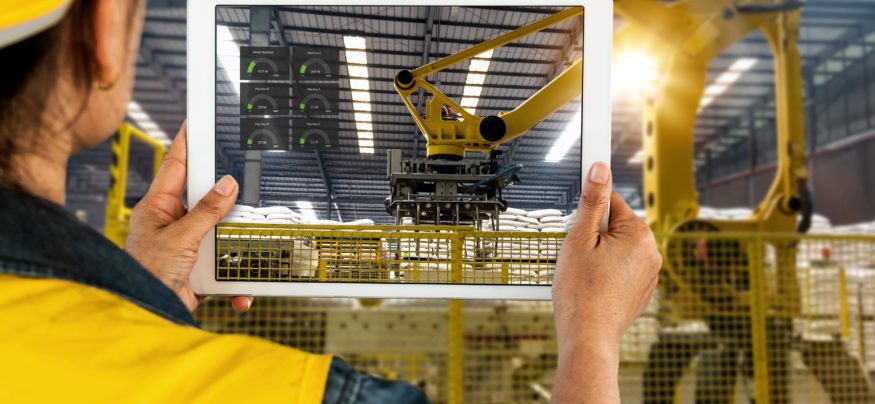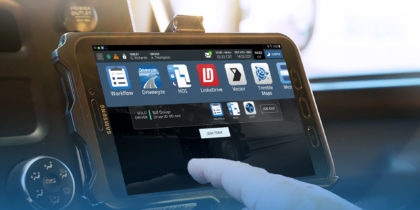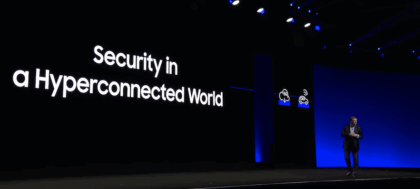In this News Insight, the Defense Transportation Journal gives a rundown on how the IoT and AI are transforming supply chain management and logistics. Mobile devices are critical to this digital transformation, but are they rugged enough to operate in industrial environments? —Samsung Insights editorial team
Thanks to ubiquitous connectivity, a plethora of sensors, advances in data analytics and machine learning, the industry is on the way towards revolutionizing the modern supply chain and transportation industries. These disruptive changes manifest themselves as new, smart capabilities in Supply Chain Management (SCM) applications especially in manufacturing, quality, maintenance, transportation, logistics and warehousing. Under the hood, these capabilities are enabled through the collection of sensor data and predictive analytics on the sensor data, along with contextual data form business applications and integration of these predictive insights into SCM/Transportation applications.
Here are some of the quantifiable benefits that many SCM organizations have reported in industry publications:
- 48 percent reduction in unplanned downtime: Unplanned downtime reduction from 11 percent to 5.8 percent due to IoT technologies.
- 16 percent improvement in Overall Equipment Efficiency (OEE): OEE improvements from 74 percent to 86 percent. This has a direct impact on overall productivity.
- Defect rate cut in nearly half: From 4.9 percent to 2.5 percent.
- 23 percent reduction in New Product Introduction cycle time: From 15 months to 11 months.
It is important to understand the positive business impact IoT, machine learning and AI are having on manufacturing, transportation and warehousing operations. There are specific technological advances that have made this possible.
Transformative Trends
IoT technologies are impacting the supply chains with the following key transformative trends, in the order of increasing potential of positive business impact:
1. Optimizations in individual supply chain functions:
Each individual supply chain function-such as manufacturing, transportation, logistics, and service-are realizing operational improvements due to IoT technologies. For example, the manufacturing sector is witnessing significant bottom-line reduction due to real-time visibility into business Key Performance Indicators (KPI) such as OEE, zero unplanned downtime, and predictive maintenance. The transportation and logistics sector is benefiting from significantly lower downtime due to real-time monitoring of trucks, on-time arrivals due to location tracking and intelligent routing, reduction in liabilities due to driver behavior monitoring, and reduction in in-transit damages due to cargo monitoring.
2. Interconnecting the supply chain (Digital Thread):
Today, individual functions in the supply chain operate in their own silo. Interconnection of the entire supply chain in a seamless Digital Thread delivers a new level of business benefits. For example, when increase in the product demand causes warehouse inventory levels to drop at a rate faster than usual, a new manufacturing order can be automatically planned and released. Shipments can be automatically planned and communicated to third-party logistics companies in real time, and product demand planning can be re-evaluated to take into account the surge in the demand signals.
3. New business models such as Servitization:
Perhaps the most disruptive impact IoT technologies have on the supply chain is that it enables new business models. Servitization, or selling products as a service, is a major trend that is disrupting many industries. Stemming from IoT-based monitoring and predictions, companies are able to sell a service with pay-as-you-go model, instead of selling a product. For example, an engine manufacturer can sell engine-hours of operation with uptime guarantees, instead of selling an engine and annual maintenance contracts. This allows their customer to shift their expense models from Capital Expenditure to Operational Expenditure (Capex to Орех) and change their consumption patterns in a fundamental way.
Key Use-cases
Using a variety of sensors, IoT Cloud applications collect data from the SCM and transportation operations. This data is used for the following purposes:
1. Event detection:
Sensor data is used to monitor various conditions such as high operating temperature, excessive vibrations, low fluid flows, overspeeding drivers, off-route driving, or low inventory levels. Combining one or more of these sensor readings and comparing against operating thresholds enables the generation of events and incidents. These events further trigger workflows in the SCM applications to automate mitigating processes.
2. Predictions:
Predictive models are built using the historical sensor data fed into machine learning or AI algorithms. The real-time sensor data is then used to evaluate using these predictive models to create real-time predictions. Organizations can take proactive steps to mitigate the impact of any potential impending problems based on these real-time predictions.
3. Root-саше analysis:
Sensor data is often used in conjunction with the contextual data from the SCM applications to find the root-cause of snags in the supply chain operations. Consider the 5M model-based root-cause analysis process in a typical manufacturing operation as an example. In order to identify the root cause of a defective product, a process engineer typically looks at the machine data (sensor data), materials/supplier data (sensor as well as contextual data), man/personnel data (contextual data), measurements (sensor data), and method (contextual) data. IoT can help analyze the machine data in the context of data from business applications.
4. Anomaly detection:
By observing sensor data over time, we can identify the normal patterns in the supply chain. Any non-standard deviations from these normal patterns can be identified from the sensor data to trigger additional scrutiny to reduce potential issues in the supply chain operations.
Business Impact
Transportation and Logistics
The business impact in the transportation and logistics operations is driven by:
- Fleet monitoring: Monitoring of fleet vehicles
- Location: Monitoring location of the vehicles at all times. This location information can be used to optimize the overall fleet, detecting route deviations, detecting unauthorized trips, etc.
- Condition: Monitoring the condition of the engine, tires, brakes, as well as operating parameters such as temperature and vibrations. This information can be used to detect any safety or operational issues with the vehicle.
- Driving technique: Monitoring for potentially harmful driving behaviors such as hard-braking or hard-cornering, and overspeeding can help minimize the risk of accidents.
- Cost management:
- Fuel cost management: Fuel cost is typically a major portion of the operating expenses of a fleet. By managing the fuel burn based on vehicle, driver, route and traffic conditions, it is possible to identify major factors contributing to excessive fuel burn. By correcting these factors, it is usually possible to reduce the overall fuel costs of operations.
- Fleet level optimizations: Due to a global picture of location and condition of each fleet vehicle and the historical patterns, it is possible to use machine learning techniques to find most optimal recommendations that optimize the fleet operations.
- Compliance:
- Using the data collected from IoT sensors can make it easier to comply with the latest regulations such as the ELD mandate.
- It is possible to automate calculations required for the International Fuel Tax Agreement (IFTA)-based tax reporting.
- Cargo monitoring:
- Monitoring the condition of cargo throughout transportation is required for various goods such as food products, pharmaceuticals and livestock transportation.
- Warehome and Yard management:
- Many processes in the yards and warehouse are manual, and hence, error-prone. Using IoT, customers can automate several tasks and optimize several others. Some examples of automation of tasks are: automated inventory and asset condition monitoring. Examples of optimization include asset and cargo location monitoring and recommendation of optimized placement plans.
IoT Enabled Logistics and Transportation Management
IoT plays a pivotal role in the modern Logistics and Transportation Management solutions. Monitoring vehicles and cargo, as well as warehouse assets provides visibility into operations. Further, monitoring driver behaviors, workers in the warehouses and conditions of the vehicles can reduce business risks through increased compliance to policies. Since fuel costs and maintenance costs are primary contributors to operating costs, IoT helps monitor the fuel burn and correlates these with IoT sensor data to help isolate rootcause of high fuel and maintenance costs.
IoT also simplifies operations by monitoring and predicting business KPIs at various levels-from vehicle level to a fleet level. However, probably the most important contribution of IoT in the modern supply chain is the ability to eliminate manual processes through automated actions based on reactive and predictive alerts.
Manufacturing
The forth industrial revolution is transforming entire manufacturing processes throughout the world. The key focus areas of this innovation are:
- Predictive maintenance: Operating parameters from production machines are collected through an IoT network, and the data is analyzed in a cloud computing environment along with other data such as supplier information and operator information. Advanced machine learning techniques are used to create predictive models of the machine operations. These models can then be used to predict failures and this information is used to automatically set up maintenance schedules. This can significantly reduce unplanned downtime, which is one of the major causes of loss of productivity in a manufacturing environment.
- Worker and machine safety: Worker safety and machine safety can be significantly improved by detecting presence of humans and machines, analyzing their work patterns and alerting human workers and/or stopping the machines when a potentially hazardous condition is either detected, or predicted using Machine Learning algorithms.
- Business model transformation: In the pay-per-use economy, there is an increasing trend of using productsas-a-service. Customers are demanding that instead of buying a large capital asset, they want to consume the services of that asset, and pay the manufacturer based on the actual usage of the asset. To enable this, IoT collects information about product usage that is driven into billing applications. In addition, proactive service can be provided by the manufacturer to maximize runtime of their assets, thereby increasing their profitability.
- Dealing with customer demand variability: The growing popularity of hyper customized products and the dynamic nature or customer demand patterns are driving significant variability in customer demands. With IoT analytics, manufacturers can predict the future demands, as well as help manufacturers deal with changing configurations of production lines and materials.
IoT Enabled Manufacturing
IoT is key to achieving the promise of Industry 4.0, or the fourth industrial revolution. First, IoT provides real-time visibility in the operations of the machines, production lines, factories, and plants. Through the use of reactive and piediaive algorithms, IoT can minimize unplanned downtime by identifying the set of machines that need maintenance before they break down. Business relevant KPIs such as OEE, or yield and quality metrics, are automatically calculated as well, as predicted using the machine learning and AI algorithms. Lastly, IoT can help improve the operations significantly by eliminating manual processes through automation, and by being proactive instead of being reactive through predictive machine learning technologies.
Implementations
Most IoT deployments in the transportation, logistics, and supply chain follow three distinct types of maturity:
- Connected assets: Many initial deployments focus on simpler use cases that answer routine questions such as where are my assets, how are they working, are there any incidents that I should be aware of, how is the utilization and availability of my assets, where can I find a nearest working asset, etc.
- Predictive insights: After the initial set of requirements is met, these deployments shift to the realm of predictive insights. Automated machine learning and AI algorithms can be employed to detect anomalous behaviors, predict equipment breakdowns and recommend corrective actions.
- Operational excellence: The most sophisticated deployments blend IoT in their business processes. They can do so by using IoT technologies to extend their business applications- such as Enterprise Resource Planning (ERP), SCM, customer service applications-to the physical world of assets, equipment and vehicles. Oracle calls this process IoTification of the business applications.
Copyright National Defense Transportation Association Feb 2018
This article was written by Atul Mahamuni from Defense Transportation Journal and was legally licensed through the NewsCred publisher network. Please direct all licensing questions to legal@newscred.com.
Learn how rugged mobile devices like the Galaxy Tab Active2 are allowing workers in transportation, logistics and manufacturing to go fearlessly and work seamlessly.
![]()







